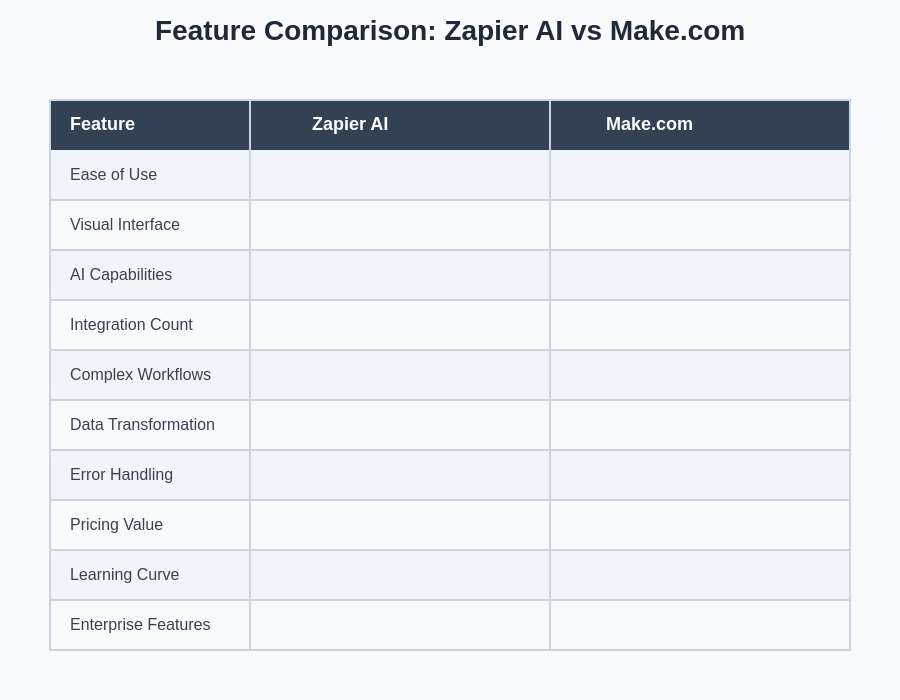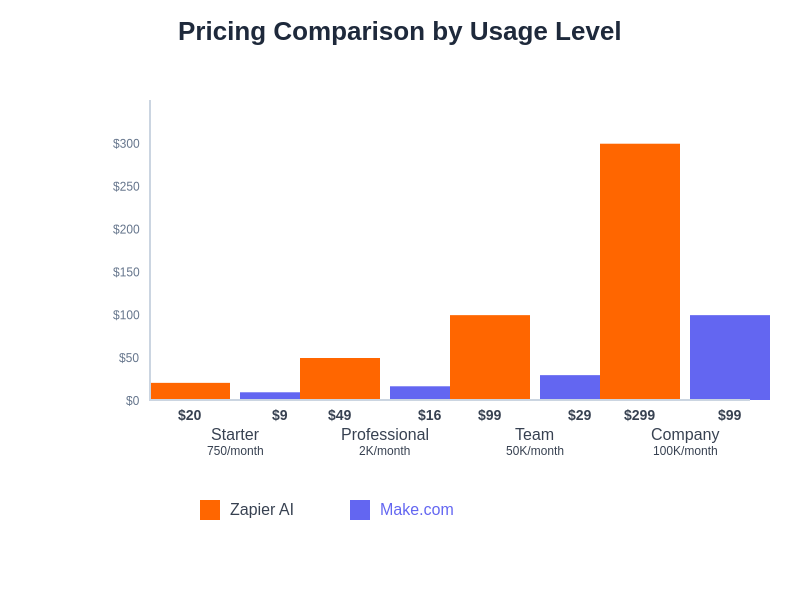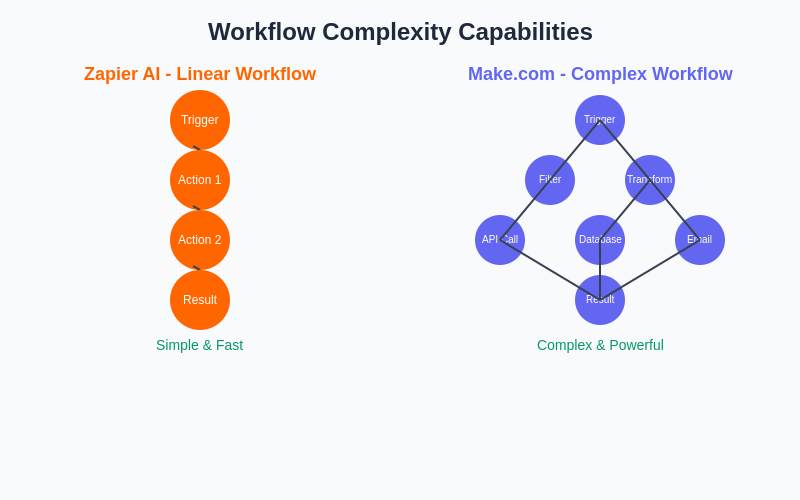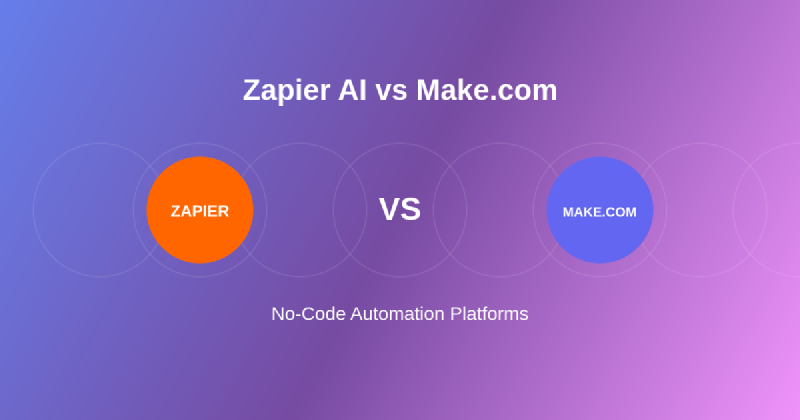The no-code automation landscape has experienced tremendous growth as businesses increasingly seek efficient ways to streamline their operations without requiring extensive technical expertise. Two platforms have emerged as dominant forces in this space: Zapier AI and Make.com, each offering unique approaches to workflow automation and integration management. These platforms have revolutionized how organizations connect disparate software applications, automate repetitive tasks, and optimize business processes through intuitive drag-and-drop interfaces and sophisticated automation logic.
Explore the latest AI automation trends to understand how these platforms are integrating cutting-edge artificial intelligence capabilities to enhance workflow automation and decision-making processes. The evolution of no-code automation represents a fundamental shift in how businesses approach technology implementation, democratizing access to powerful automation capabilities that were previously available only to organizations with substantial technical resources and development expertise.
Understanding No-Code Automation Platforms
No-code automation platforms have emerged as transformative solutions that enable businesses to create sophisticated workflows and integrations without writing a single line of code. These platforms provide visual interfaces that allow users to design complex automation sequences using simple drag-and-drop functionality, conditional logic, and pre-built connectors to thousands of popular business applications. The democratization of automation technology has empowered non-technical users to become automation architects, capable of designing and implementing solutions that significantly improve operational efficiency and reduce manual workload.
The fundamental appeal of no-code automation lies in its ability to bridge the gap between business requirements and technical implementation. Traditional automation solutions often required extensive development resources, lengthy implementation cycles, and ongoing maintenance by technical teams. Modern no-code platforms have eliminated these barriers by providing intuitive interfaces that translate business logic into functional automation workflows, enabling rapid deployment and iteration of automated processes across diverse organizational functions.
Zapier AI: Evolution of a Automation Pioneer
Zapier has long been recognized as a pioneer in the no-code automation space, and the introduction of AI capabilities has further solidified its position as a market leader. The platform’s approach to automation centers around the concept of “Zaps,” which are automated workflows that connect two or more applications to perform specific tasks when triggered by predetermined conditions. Zapier AI has enhanced this fundamental concept by incorporating artificial intelligence to make automation creation more intuitive, intelligent, and adaptive to changing business requirements.
The AI integration within Zapier manifests in several key areas, including intelligent automation suggestions, natural language processing for workflow creation, and adaptive trigger optimization that learns from user behavior patterns. These AI enhancements have transformed Zapier from a simple connector platform into an intelligent automation assistant that can predict user needs, suggest optimal workflow configurations, and continuously optimize automation performance based on real-world usage data and outcomes.
Discover advanced AI capabilities with Claude for building sophisticated automation workflows that leverage natural language processing and intelligent decision-making capabilities. The integration of AI into automation platforms represents a significant leap forward in making these tools more accessible and effective for users across all skill levels and technical backgrounds.
Make.com: Visual Automation Redefined
Make.com, formerly known as Integromat, has distinguished itself through its highly visual approach to automation design and its emphasis on providing granular control over workflow logic and data manipulation. The platform’s strength lies in its sophisticated scenario builder that allows users to create complex, multi-branch workflows with detailed conditional logic, error handling, and data transformation capabilities. This visual paradigm makes it particularly appealing to users who prefer to see the complete automation flow and understand the relationships between different workflow components.
The platform’s approach to automation design emphasizes transparency and control, providing users with detailed visibility into data flow, execution paths, and transformation processes. Make.com’s interface resembles a flowchart or mind map, where each automation component is represented as a node that can be configured, connected, and optimized to create sophisticated business processes. This visual representation makes it easier for users to troubleshoot issues, optimize performance, and maintain complex automation workflows over time.
Feature Comparison: Depth vs. Accessibility
The feature sets of Zapier AI and Make.com reflect different philosophical approaches to no-code automation, with each platform optimizing for distinct user preferences and use cases. Zapier AI prioritizes simplicity and accessibility, focusing on making automation creation as straightforward as possible while leveraging artificial intelligence to guide users through the process and optimize workflow performance. The platform excels in scenarios where users need quick, reliable automation solutions without extensive configuration or customization requirements.
Make.com, conversely, emphasizes depth and flexibility, providing users with extensive customization options, advanced data manipulation capabilities, and sophisticated conditional logic that can handle complex business scenarios. The platform is particularly well-suited for organizations that require detailed control over automation workflows, need to handle complex data transformations, or want to create sophisticated multi-step processes with multiple decision points and error handling mechanisms.

The comprehensive feature analysis reveals distinct strengths in each platform, with Zapier AI excelling in ease of use and AI capabilities while Make.com leads in visual interface design and complex workflow management. This differentiation helps organizations align platform selection with their specific automation requirements and technical capabilities.
The integration ecosystems of both platforms are extensive, though they differ in their approach to connector development and maintenance. Zapier AI benefits from its longer market presence and has cultivated relationships with thousands of software vendors, resulting in a vast library of pre-built integrations that cover virtually every popular business application. Make.com has focused on developing high-quality, feature-rich connectors that often provide more granular control and advanced functionality compared to their Zapier counterparts.
User Interface and Experience Design
The user interface design philosophies of Zapier AI and Make.com reflect their respective approaches to automation complexity and user empowerment. Zapier AI maintains a clean, minimalist interface that guides users through automation creation using a step-by-step wizard approach. This design prioritizes speed and simplicity, allowing users to create functional automation workflows in minutes rather than hours. The AI integration enhances this experience by providing intelligent suggestions, auto-completing common workflow patterns, and offering optimization recommendations based on best practices.
Make.com’s interface embraces visual complexity as a feature rather than a limitation, providing users with a canvas-like environment where automation workflows are constructed as interconnected nodes and pathways. This approach requires a steeper learning curve but rewards users with unprecedented visibility into automation logic and extensive customization capabilities. The platform’s interface design acknowledges that many automation scenarios require sophisticated logic and provides the tools necessary to implement and maintain complex workflows effectively.
Pricing Models and Value Propositions
The pricing strategies of Zapier AI and Make.com reflect their different target audiences and value propositions, with each platform offering tiered pricing structures that scale with usage and feature requirements. Zapier AI employs a task-based pricing model where users pay based on the number of automated actions performed by their workflows. This approach provides predictable costs for organizations with consistent automation usage patterns and aligns pricing with actual value delivered through automation efficiency gains.
Make.com utilizes an operations-based pricing model that charges based on the number of operations performed across all scenarios, regardless of the complexity or number of applications involved in each operation. This pricing structure can be more cost-effective for organizations that run complex workflows involving multiple applications and data transformations, as the cost is based on execution frequency rather than the sophistication of the automation logic.

The pricing analysis demonstrates significant cost variations between the platforms across different usage tiers, with Make.com generally offering more competitive pricing for higher-volume automation scenarios while Zapier AI’s pricing reflects its premium positioning and extensive integration ecosystem.
Enhance your automation research with Perplexity to gather comprehensive information about pricing changes, feature updates, and competitive analysis for no-code automation platforms. The dynamic nature of the software-as-a-service landscape means that pricing models and feature sets evolve rapidly, requiring ongoing evaluation to ensure optimal platform selection and configuration.
Integration Ecosystem and Connectivity
The breadth and depth of integration capabilities represent crucial differentiators between Zapier AI and Make.com, as the value of any automation platform is fundamentally limited by its ability to connect with the applications and services that businesses actually use. Zapier AI has built its reputation on having the most extensive integration ecosystem in the no-code automation space, with native connectors to thousands of popular business applications spanning categories from customer relationship management to financial services to creative tools.
The quality and functionality of these integrations vary significantly, with popular applications typically receiving comprehensive connector development that exposes most or all of the application’s API functionality. Less common applications may have basic connectors that support only essential operations, though Zapier’s webhook functionality and custom integration capabilities provide pathways for connecting virtually any web-based service that offers API access.
Make.com has pursued a different strategy, focusing on developing fewer but more sophisticated integrations that provide extensive functionality and granular control over API interactions. Many of Make.com’s connectors offer advanced features such as custom API calls, detailed error handling, and sophisticated data transformation capabilities that go beyond simple data passing between applications. This approach results in more powerful integration capabilities for supported applications, though the overall ecosystem may not be as comprehensive as Zapier’s offering.
Automation Complexity and Scalability
The scalability characteristics of Zapier AI and Make.com become apparent when examining their approaches to handling complex, multi-step automation scenarios that involve conditional logic, error handling, and data transformation requirements. Zapier AI excels at creating straightforward, linear automation workflows that perform well at scale but may struggle with scenarios requiring complex branching logic or sophisticated data manipulation. The platform’s strength lies in its ability to handle high-volume, simple automation tasks reliably and efficiently.
Make.com’s architecture is specifically designed to handle complex automation scenarios that involve multiple decision points, parallel processing paths, and sophisticated data transformations. The platform’s scenario execution engine can manage workflows with dozens of interconnected modules, complex conditional logic, and advanced error handling mechanisms. This capability makes Make.com particularly suitable for organizations that need to automate complex business processes that cannot be adequately addressed through simple trigger-action sequences.

The workflow complexity visualization illustrates the fundamental architectural differences between the platforms, with Zapier AI optimized for linear, straightforward automation sequences while Make.com excels at managing complex, multi-branched workflows with sophisticated logic and data processing capabilities.
Artificial Intelligence and Smart Automation
The integration of artificial intelligence capabilities represents a significant differentiator between modern automation platforms, and both Zapier AI and Make.com have invested in AI-powered features that enhance user experience and automation effectiveness. Zapier AI’s approach to artificial intelligence focuses on user assistance and automation optimization, utilizing machine learning algorithms to suggest workflow improvements, predict user intentions, and optimize trigger conditions based on historical performance data.
The AI capabilities within Zapier extend to natural language processing features that allow users to describe desired automation outcomes in plain English, with the system automatically generating appropriate workflow configurations. This functionality significantly reduces the barrier to entry for non-technical users while ensuring that automation workflows follow best practices and optimization guidelines developed through analysis of millions of successful automation implementations.
Make.com has incorporated AI features that focus on data analysis and workflow optimization, providing users with intelligent insights into automation performance, bottleneck identification, and optimization recommendations. The platform’s AI capabilities are particularly strong in areas related to data transformation and manipulation, offering smart suggestions for handling complex data mapping scenarios and providing automated error detection and resolution capabilities.
Performance, Reliability, and Monitoring
The operational reliability and performance characteristics of automation platforms directly impact business operations, making platform stability and monitoring capabilities crucial evaluation criteria for organizations considering Zapier AI or Make.com. Zapier AI has invested significantly in infrastructure reliability, offering robust uptime guarantees and comprehensive monitoring capabilities that provide users with detailed visibility into automation execution status, error rates, and performance metrics.
The platform’s approach to reliability emphasizes redundancy and graceful error handling, with built-in retry mechanisms, dead letter queues for failed automations, and comprehensive logging that enables rapid troubleshooting of issues. Zapier AI’s monitoring dashboard provides real-time insights into automation performance, including execution times, success rates, and resource consumption metrics that help users optimize their workflows for maximum efficiency and reliability.
Make.com has developed sophisticated monitoring and debugging capabilities that align with its emphasis on workflow complexity and customization. The platform provides detailed execution logs, real-time scenario monitoring, and advanced debugging tools that allow users to inspect data flow at each step of complex automation workflows. These capabilities are particularly valuable for organizations running mission-critical automation processes that require detailed visibility and rapid issue resolution.
Data Security and Compliance Considerations
Data security and regulatory compliance represent critical considerations for organizations evaluating no-code automation platforms, particularly given the sensitive nature of business data that flows through automation workflows. Both Zapier AI and Make.com have implemented comprehensive security frameworks that address encryption, access control, audit logging, and compliance with major regulatory standards such as GDPR, SOC 2, and industry-specific requirements.
Zapier AI’s security approach emphasizes data minimization and secure transmission, with policies that limit data retention, implement end-to-end encryption for data in transit, and provide granular access controls for team management. The platform’s compliance certifications cover major international standards and provide assurance for organizations operating in regulated industries such as healthcare, finance, and government services.
Make.com has developed security capabilities that align with its emphasis on data transformation and complex workflow management, providing detailed audit trails, comprehensive data lineage tracking, and advanced access control mechanisms that support role-based permissions and segregation of duties. The platform’s security architecture is designed to handle sensitive data processing scenarios while maintaining compliance with relevant regulatory requirements.
Team Collaboration and Enterprise Features
The collaborative capabilities and enterprise features of automation platforms become increasingly important as organizations scale their automation initiatives and involve multiple team members in workflow design, maintenance, and optimization. Zapier AI has developed team collaboration features that emphasize simplicity and ease of use, providing shared workspace capabilities, role-based access controls, and collaborative editing features that enable teams to work together effectively on automation projects.
The platform’s enterprise features include advanced user management, single sign-on integration, and comprehensive audit logging that supports organizational governance requirements. Zapier AI’s approach to team collaboration focuses on maintaining the platform’s core simplicity while providing the administrative controls and oversight capabilities that enterprise organizations require for successful automation program management.
Make.com offers more sophisticated team collaboration capabilities that align with its emphasis on complex workflow management and detailed customization. The platform provides advanced project organization features, detailed permission management, and collaborative debugging capabilities that enable technical teams to work together on sophisticated automation scenarios. These features are particularly valuable for organizations with dedicated automation teams or those implementing complex, multi-departmental automation initiatives.
Future Roadmaps and Innovation Directions
The future development trajectories of Zapier AI and Make.com reflect their respective strategic focuses and market positioning, with both platforms investing in capabilities that will define the next generation of no-code automation solutions. Zapier AI’s roadmap emphasizes continued AI integration, with plans for more sophisticated natural language processing, predictive automation capabilities, and intelligent workflow optimization that adapts to changing business conditions and user behavior patterns.
The platform’s innovation focus includes expanding AI-powered features such as automatic data mapping, intelligent error resolution, and predictive maintenance capabilities that can identify and resolve potential automation issues before they impact business operations. These developments align with Zapier’s mission to make automation accessible to non-technical users while providing enterprise-grade reliability and performance.
Make.com’s future development emphasizes enhanced visual design capabilities, more sophisticated data processing features, and expanded integration with emerging technologies such as artificial intelligence, machine learning, and Internet of Things platforms. The platform’s roadmap includes plans for advanced scenario templating, improved collaborative features, and enhanced debugging capabilities that will further strengthen its position as a platform for complex automation scenarios.
Making the Right Choice for Your Organization
The decision between Zapier AI and Make.com ultimately depends on organizational requirements, technical expertise, complexity needs, and long-term automation strategy. Organizations that prioritize ease of use, rapid implementation, and broad integration coverage will likely find Zapier AI to be the optimal choice, particularly if their automation needs center around straightforward trigger-action scenarios and they value AI-powered assistance in workflow creation and optimization.
Companies that require sophisticated automation workflows, detailed customization capabilities, and granular control over data processing will benefit more from Make.com’s feature set and design philosophy. The platform is particularly well-suited for organizations with technical teams that can leverage its advanced capabilities or businesses that need to implement complex automation scenarios that cannot be adequately addressed through simpler platforms.
The evaluation process should include consideration of factors such as existing technology stack integration requirements, team technical expertise, scalability needs, budget constraints, and long-term automation strategy. Both platforms offer trial periods and extensive documentation that enable hands-on evaluation of their capabilities and suitability for specific organizational needs.
The future of no-code automation continues to evolve rapidly, with both Zapier AI and Make.com representing different but equally valid approaches to democratizing automation technology. The choice between these platforms should align with organizational culture, technical requirements, and strategic objectives while considering the potential for future needs evolution and platform capabilities growth. Success with either platform depends not just on feature compatibility but on organizational commitment to automation excellence and continuous process improvement.
Disclaimer
This article is for informational purposes only and does not constitute professional advice. The comparisons and analyses presented are based on publicly available information and general market understanding as of the publication date. Readers should conduct their own thorough evaluation of automation platforms based on their specific requirements, budget constraints, and technical needs. Platform features, pricing, and capabilities are subject to change, and organizations should verify current information directly with vendors before making implementation decisions.
